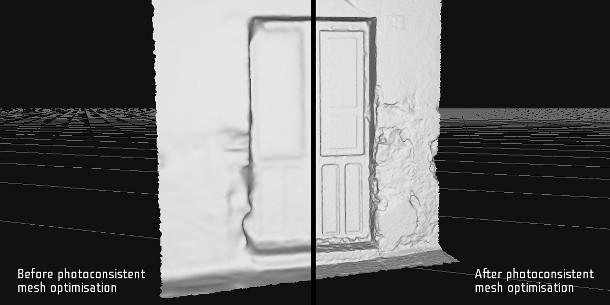3Dflow ships 3DF Zephyr 3.3
Originally posted on 14 November 2016. Scroll down for news of the 3.1, 3.2 and 3.3 updates.
3Dflow has released 3DF Zephyr 3.0, the latest update to its image-based modelling software, adding a new method for generating much crisper, more detailed meshes from source images.
The update also adds a new pipeline for generating sparse point cloud reconstruction of scenes, and adds support for the .fls and .fws laser scan data formats.

New photoconsistency-based optimisation creates crisper, more detailed meshes
One interesting new feature in 3DF Zephyr 3.0 is its new photoconsistency-based mesh optimisation system, which generates crisper, more detailed meshes, at the expense of extra processing time.
3Dflow doesn’t put a figure on that extra time, but the examples in its blog post show quite a significant improvement in mesh quality, particularly with source images from drone footage.
Faster reconstruction of sparse point clouds, support for new laser scan data formats
The update also adds a new global pipeline for reconstructing sparse point clouds from source images, based on 3DFLow’s 3DF Samantha technology.
The new pipeline is described as “powerful and faster”, although again, 3Dflow doesn’t put any figures on the speed boost.
Updated: 3Dflow has been in touch to point out that there are comparative figures on its blog.
Keypoint matching is now “up to 90% faster on a entry-level machine”, and when other parts of the pipeline are taken into account, version 3.0 is over twice as fast as 2.7 on the data set used in 3Dflow’s tests.
The developer has also begun to add support for the native file formats of laser scanners, enabling users to view raw scan data inside 3DF Zephyr.
The 3.0 update adds support for Faro’s .fls and .fws formats, but 3Dflow says that it will make more formats available in future through free downloadable plugins.
Other new features for users of the high-end editions
Users of the Pro and Aerial versions of the software also get a new Multi ICP algorithm for registering point cloud scans; and Aerial users get new options for extracting polylines.
There are also a number of smaller new features, which you can find via the link at the foot of the story.
Pricing and availability
3DF Zephyr 3.0 is available for 64-bit Windows Vista and above. The update is free to users of the Lite edition of the software, which is aimed at less demanding entertainment work.
The price of the Lite version has been cut by $50, to $149; the Pro edition costs $3,200; and the Aerial edition is up $400, to $4,200. All prices exclude VAT. See a comparison table of the three editions.
Read a full list of new features in 3DF Zephyr 3.0 on 3Dflow’s blog
Updated 9 March 2017: 3Dflow has released 3DF Zephyr 3.1. The update adds support for a greater range of camera RAW formats, support for 4K monitors, and early support for processing equirectangular photos.
Read a full list of new features in 3DF Zephyr 3.1 on 3Dflow’s blog.
Updated 19 May 2017: 3Dflow has released 3DF Zephyr 3.2. It’s mainly a performance and bugfix update, but alongside it, the firm has released 3DF Zephyr Free, a new free version of the software for personal use.
Read a full list of new features in 3DF Zephyr 3.2 on 3Dflow’s blog
Updated 4 July 2017: 3Dflow has released 3DF Zephyr 3.3. Again, it’s largely a performance update, but it also adds the option to apply filters to geometry selections: for example, to retopologise an individual component of a mesh, rather than the entire model.
Read a full list of new features in 3DF Zephyr 3.2 on 3Dflow’s blog
